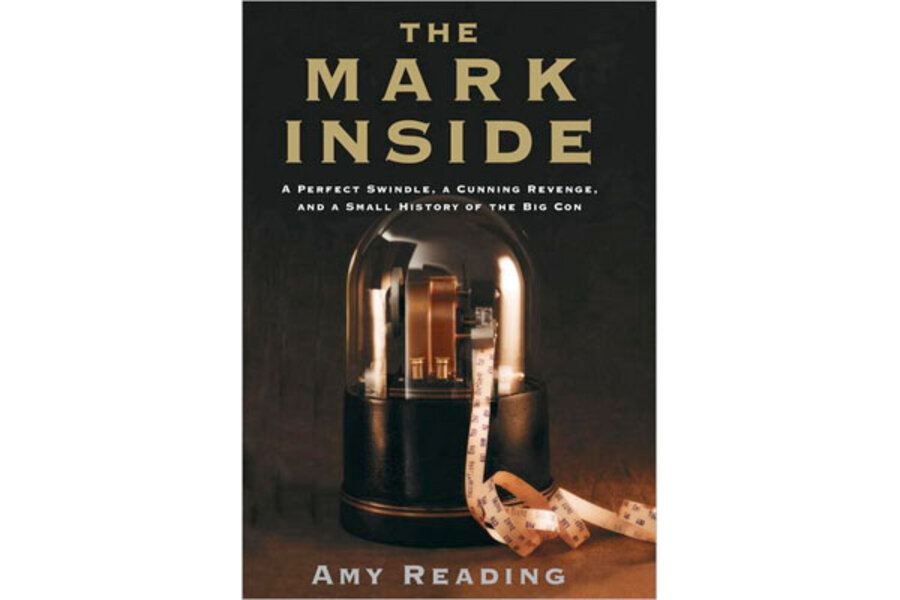A victim turns the tables on con men
Loading...
Back in the glory days of the Big Con, rich people who got swindled rarely made a stink.
They were humiliated and embarrassed. And they often worried that the law enforcement would go after them because many of the schemes were designed to rip off someone else.
But a rancher from Texas who lost a bundle in 1919 decided to tell the world about his epic hoodwinking by an expert gang of grifters. And then he did something else: He got them back in a sting that would have made Paul Newman and Robert Redford proud.
Amy Reading, a journalist based in Ithaca, N.Y., chronicles his story and more in the new book The Mark Inside: A Perfect Swindle, a Cunning Revenge, and a Small History of the Big Con.
I asked Reading about the history of the swindle in America, the inner workings of the Big Con, and the man who conned the con men.
Q: How did the term "confidence man" – shortened to "con man" – come about in the first place?
A: It's an American story.
There were definitely swindlers and con men before then. But the name comes from 1849 when a man with many aliases was walking the streets of New York. He'd go up to people and ask if he knew them. He'd be so charming and gracious that they'd believe they did know him.
He'd engage them in conversation, and then he'd say, "Do you have enough confidence in me to lend me your watch?"
The frame of that social encounter was so strong that the mark would hand over the watch, maybe internally mystified but not wanting to call out this account as strange. Then the confidence man would saunter off with the watch.
The word "confidence" became an instant meme, as we'd call it now, a catchword for what had been happening for centuries.
Q: Swindles had been around for a long time?
A: You can trace it to early modern Europe. A swindler is a particular kind of thief who steals by engaging in someone's trust. It's definitely something that bedeviled the commentators and philosophers of the day who are concerned about what this means for the conditions of trust in society.
Q: You tell the real-life story of a rancher who was swindled in an elaborate con with multiple players and scenes, a lot like the movie "The Sting." How did cons get so complicated when they used to be just one guy asking for another's watch?
A: It goes from being a one-act play to a three-act play with a script and sets and actors, and a particular way of hooking the mark. It's an outgrowth of the gambling impulse and a somewhat more respectable impulse to invest via speculation, on margin.
Q: How would it play out?
A: It never begins with an all-out pitch for the mark's greediness. We're all on guard for something for nothing. So the swindler would invite the mark to help out with a gesture of friendship or philanthropy; it isn't initially a call to join something illegal.
The more the mark gets reeled into the con, the more there are these winks and nods about the legality or morality of the situation. The more he drawn in, the fewer chances he has to speak up and ask questions.
At some point, the mark is invited to join something that he thinks has been rigged in his favor and he can't possibly lose. It's done so gradually that it's never seen as magical or impossible money. It's got to seem rational or plausible.
Q: What makes this swindled rancher so interesting to you?
He's a hoot. He's a very fallible man who went undercover posed as a mark to outcon his con men. Then he turned his tale into a memoir that itself has layers of meaning that you can get if you scratch at them.
He thought a lot about storytelling. He was a great storyteller, but also came to realize that all storytelling is a kind of swindle. All narrative participates in the logic of the con in some degree, and you can see it in mine as well. You release information at certain points and bring the reader along, which is not so different from telling the tale to the mark to get them to react at certain key moments. I think he appreciated that.
Q: Without giving away what he does to get back at the men who conned him, would you say his revenge is delicious?
A: His revenge is on his own terms.
In the script, the last scene is where he is supposed to slink home and never speak out of what just happened out of shame and fear that he might be prosecuted.
But he rewrites the story that he finds himself in and reverses everything. It grows bigger and bigger, but he retains control.
The swindlers get hoisted on their own petard, but not without complications. There's conning and re-conning that goes on. These are people who are quite good at turning tables, and to catch them he had to learn their logic and learn this script of the con, and learn the way whole towns were fixed up with law enforcement so the con could unfold without rippling the municipal waters.
He becomes the ultimate spieler. And then he went on for the rest of his long life to tell this story over and over again.
Randy Dotinga is a Monitor correspondent.







